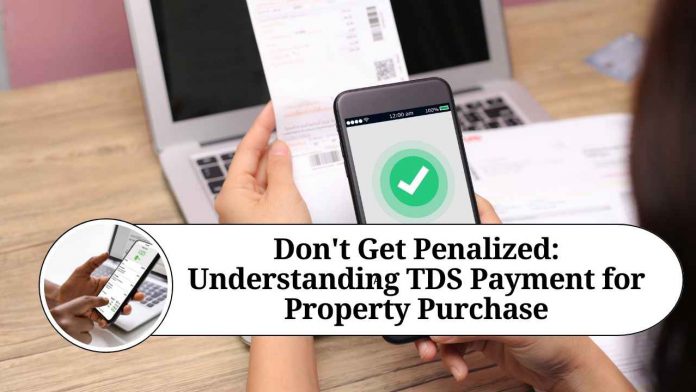Step 1: Calculate the TDS amount
The first step in paying TDS for the purchase of property is to calculate the amount of TDS that needs to be paid. The TDS rate for the purchase of property is 1% of the total sale consideration (i.e., the total amount paid for the property). However, if the seller is an NRI (Non-Resident Indian), the TDS rate is 20% (subject to certain conditions).
Step 2: Obtain the TAN of the seller
The next step is to obtain the TAN (Tax Deduction and Collection Account Number) of the seller. TAN is a 10-digit alphanumeric code that is required to pay TDS. You can obtain the TAN from the seller or check it online on the Income Tax Department’s website.
Step 3: File Form 26QB
Once you have calculated the TDS amount and obtained the TAN of the seller, the next step is to file Form 26QB. Form 26QB is a statement-cum-challan for the payment of TDS on the purchase of the property. It can be filed online on the NSDL website or the TIN-NSDL website. You will need to provide details such as the PAN of the buyer and seller, the TAN of the seller, the amount paid for the property, and the TDS amount.
Step 4: Make the payment
After filing Form 26QB, the next step is to make the TDS payment. You can make the payment online through net banking or a debit card. Once the payment is made, you will receive a challan-cum-receipt, which you should keep for future reference.
Step 5: Download the TDS certificate
After making the TDS payment, the next step is to download the TDS certificate. The TDS certificate is also known as Form 16B and is issued by the buyer to the seller as proof of TDS payment. You can download the TDS certificate from the TRACES website by entering the details such as the acknowledgment number of Form 26QB, the PAN of the buyer and seller, and the assessment year.
It is important to note that TDS for the purchase of property is applicable only if the sale consideration is more than Rs. 50 lakhs. In case the sale consideration is less than Rs. 50 lakhs, TDS is not required to be deducted.
Another important thing to keep in mind while paying TDS is that the TDS amount should be paid within 30 days from the end of the month in which the TDS was deducted. For example, if the TDS was deducted on 15th May, the TDS amount should be paid by 30th June.
It is also important to ensure that the details entered in Form 26QB are accurate. Any mistakes in the details can result in a delay or rejection of the payment. Therefore, it is advisable to double-check the details before submitting the form.
conclusion
paying TDS for the purchase of property is an important step that should not be taken lightly. By following the above steps and ensuring compliance with tax laws, you can avoid any legal complications and ensure a smooth transaction. It is always better to seek professional advice in case of any doubts or queries regarding the TDS payment process.
Other Related Blogs: Section 144B Income Tax Act
Frequently Asked Questions (FAQs) on Paying TDS for Purchase of Property
Q: What is TDS and why is it applicable for the purchase of property?
A: TDS stands for Tax Deducted at Source. It is a tax that is deducted at the source of payment and is applicable on certain types of payments, including payments made towards the purchase of property. TDS is applicable for the purchase of property to ensure that the buyer deducts tax at the time of making payment to the seller.
Q: What is the TDS rate for the purchase of property?
A: The TDS rate for the purchase of property is 1% of the total sale consideration (i.e., the total amount paid for the property). However, if the seller is an NRI (Non-Resident Indian), the TDS rate is 20% (subject to certain conditions).
Q: Is TDS applicable if the sale consideration is less than Rs. 50 lakhs?
A: TDS for the purchase of property is applicable only if the sale consideration is more than Rs. 50 lakhs. In case the sale consideration is less than Rs. 50 lakhs, TDS is not required to be deducted.
Q: How can I obtain the TAN of the seller?
A: You can obtain the TAN (Tax Deduction and Collection Account Number) of the seller from the seller or check it online on the Income Tax Department’s website.
Q: What is Form 26QB?
A: Form 26QB is a statement-cum-challan for the payment of TDS on the purchase of the property. It can be filed online on the NSDL website or the TIN-NSDL website.
Q: How can I make the TDS payment?
A: You can make the TDS payment online through net banking or a debit card.
Q: What is the deadline for paying TDS for the purchase of property?
A: The TDS amount should be paid within 30 days from the end of the month in which the TDS was deducted.
Q: What is the TDS certificate and how can I obtain it?
A: The TDS certificate is also known as Form 16B and is issued by the buyer to the seller as proof of TDS payment. You can download the TDS certificate from the TRACES website by entering the details such as the acknowledgment number of Form 26QB, the PAN of the buyer and seller, and the assessment year.
Q: What happens if I fail to pay TDS for the purchase of property?
A: Failing to pay TDS can result in penalties and legal consequences. Therefore, it is important to ensure that you follow the correct procedure while paying TDS.




















